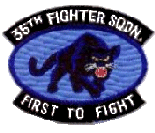I’m writing this article for two audiences: my weekly Madison County Carrier readers and a website developed by a lawyer in Phoenix, Rick Keyt. In his website (keytlaw.com), Rick has developed an extensive link, “Flying the F-4 Phantom,” primarily about the 35th Tactical Fighter Squadron from 1972-73. One of Rick’s articles is called “GIB LADD” about a crash on takeoff that many of us witnessed, so I’m giving you my perspective from what I recall.
It was late March 1973 and our squadron had returned five months earlier from the war in Southeast Asia to our home base at Kunsan, Korea. We (3rd Tactical Fighter Wing) were receiving an ORI – Operational Readiness Inspection – from our parent command, the Pacific Air Forces. On this morning, we were called on to fly a simulated nuclear mission, a single heavy bomb drop at Kooni Range, about a hundred miles north of Kunsan.
I was flying that morning with Gary “Stump” Corbett, a classmate from USAFA 1970. We were just a couple of lieutenants doing our thing on a brisk winter morning. Our F-4D configuration was three external fuel tanks (for a total fuel load of 21,000 pounds) and a 2100 pound BDU-8 practice bomb on the left inboard station. The jet was pretty close to maximum gross takeoff weight of 58,000 pounds.
As I recall, our call sign was Deben 93. Our mission called for us to takeoff to the south and turn left; fly a 20 minute low level route at 500 feet, 420 knots; accelerate to 500 knots at the initial point (IP) south of the range; and attack the scored offshore target with our BDU-8, delivering the bomb from low level. It was a typical attack profile for our nuclear mission.
So Corbett is taxing our jet and I have my head down in the rear cockpit tuning the radar and checking our timing, mission details, etc. Our UHF radio is tuned to the tower frequency, normal for ground operations.
Somewhere along that taxiway near the north end of the airfield, I hear a call from the tower, “Deben 91, you’re on fire.” Now to be honest, I was so engrossed in my work (don’t forget, this is an ORI) that all I heard or registered was the call sign (Deben) and the word “fire.” This is not comforting when you’re riding in an F-4 filled with jet fuel. I might add that JP-4 was a particularly volatile fuel mixed with naphtha (fortunately no longer in use by Air Force fighters).
So I pull my head out of the cockpit and start looking at instruments, warning lights, and mirrors to see if we are the Deben on fire. Then I hear Stump exclaim over the intercom, “Oh my God; they’re going to crash.” I swiveled my head to about 9 o’clock and see a mushrooming fireball of 21,000 pounds of jet fuel being consumed. The conflagration was off the south end of the runway over water and no chutes (parachutes which would indicate the crew ejected) were visible.
I have been to many aircraft accident sites investigating why jets crash, but this is the first and only one I witnessed as it was taking place. It was both eye-watering and sobering. Neither Corbett nor I were enthusiastic about flying at that point.
We taxied our jet out to the end of the runway, 2 miles from where all the action was. Our takeoff was delayed and we listening on Tower to all the discussion. From my lineup card, I figured out that Deben 91 was being flown by Chuck Banks and Ron Price. Ron and I were supposed to have left that day at the conclusion of our 13 month assignment … but our departure was delayed to fly for the ORI.
At some point, we learned from the radio calls that both Chuck and Ron had successfully (but barely) escaped the burning jet and were in their individual life rafts off the south end of the runway. Whew.
After about 20 minutes of waiting, we were given clearance to takeoff and fly our mission. We blasted off to the south overhead of our squadron buddies and turned left to point the jet toward Kooni to the north. Our TOT (time over target) was blown because of the delay. We threw the low level route away and I gave Stump and straight vector to the IP. I swear, he never pulled the throttles out of military (100 percent) power. We streaked over the Korean countryside low level at more than 600 knots. We actually had to slow down in order to drop the bomb, which is counter-intuitive.
How close was our bomb to the target? I have no idea. A couple of days later, I was on the “freedom bird” departing Korea, returning to my young family and getting ready for another overseas assignment. Price was on the same aircraft home. He was OK. Chuck was a little more banged up than Ron. We deduced their centerline tank leaked, pouring raw jet fuel into the engines through the open aux air doors. After several similar accidents, the emergency procedure for fire on takeoff was amended to include jettisoning the centerline tank.
Even after more than forty years, I’m pretty sure of most of the details. You don’t forget things like that.

Leave A Comment